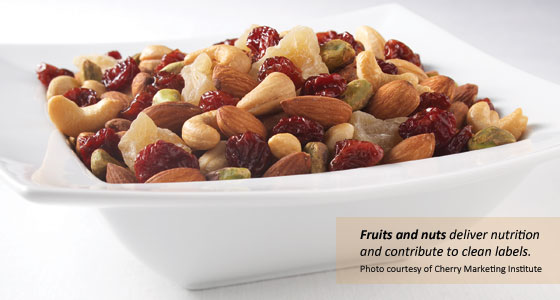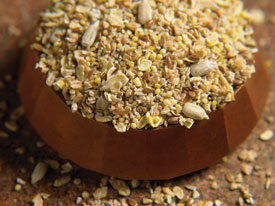Wholesome Nutrition
NUTRACEUTICALS

A walk around this year’s Natural Products Expo West in Anaheim provided a peek at the growing trend for less processed foods, raw foods, and clean labels. As consumers drift back to more “basic” foods, the call for whole food ingredients has increased. Whole food ingredients offer natural and nutritional benefits, not to mention a cleaner label. Here is a look at the nutritional impact of some whole food ingredients, including fruits, whole grains, and nuts.
Fruits
Superfruits such as açai berries are sought after in part for their reported high antioxidant content. Thanks to growing research on the antioxidant properties of various fruits, more are stepping into the limelight as whole food ingredients.
Tart cherries are rich in antioxidants and anthocyanins, and have been shown to possibly help reduce chronic inflammation, especially for those suffering from joint pain and arthritis. The Red Report, available through The Cherry Marketing Institute, Lansing, Mich. (www.choosecherries.com), features more than 50 peer-reviewed scientific studies on tart cherries. It is the first compilation to include the latest research supporting tart cherries’ exercise recovery and pain relief benefits. For example, research from Oregon Health & Science University was presented at last year’s American College of Sports Medicine Conference, highlighting the anti-inflammatory benefits of cherries (Cherry Marketing Institute, 2012). In the study of 20 women ages 40 to 70 with inflammatory osteoarthritis, the researchers found that drinking tart cherry juice twice daily for three weeks led to significant reductions in important inflammation markers, especially for women who had the highest inflammation levels at the start of the study.
Goji berries were introduced earlier this year by iTi Tropicals, Lawrenceville, N.J. (www.ititropicals.com). Lychee was also reintroduced. Goji berries contain 18 amino acids and have 21 minerals such as zinc, iron, copper, calcium, germanium, selenium, and phosphorus. Goji berries are a source of carotenoids, which include beta-carotene. The company offers goji juice/puree and 36 brix goji juice concentrate. Lychee fruit has no cholesterol and is low in sodium and a very good source of vitamin C. The company offers single-strength lychee juice and lychee concentrate from India.
In addition to juices and concentrate, companies also offer powder ingredients that deliver the benefits of whole fruits. “Carrot, beet, pumpkin, and blueberry powders are our most commonly requested ingredients,” says Frank Davis, Chief Executive Officer, Food for Health International Orem, Utah (www.foodforhealthinternational.com). “Carrot and pumpkin are popular for their vitamin A content, which supports healthy vision and provides antioxidants. Beet is gaining popularity, especially with athletes, for its nitric oxide and betaine, which support endurance. Blueberry is popular for its flavor and color, as well as its overall phytonutrient content.”
Food for Health offers a line of whole-food powders. “It is unique in that our whole-food powders deliver original nutrition from whole-food sources—never from synthetic vitamins,” explains Davis. “Our powders also deliver real color and full flavor, eliminating any need for artificial colors and flavors, and have impressive shelf lives without needing a single preservative.” The powders can be used as ingredients in products such as juice, coffee, tea, icing and spreads, candies, specialty nuts, and dry mixes for cakes, soups, or sauces. Davis adds that they can also be used as standalone ingredients, offering customers long-lasting, unspoiled nutrition in their pantry to be used however they see fit—in smoothies, as a vitamin boost in water, for baked goods, on breakfast cereal/oatmeal, or in ice cream.
--- PAGE BREAK ---
 Maquiberry is a new addition to a line of ingredients from FMC BioPolymer, Philadelphia, Pa. (www.fmc.com). MaQBerry® brand extract, available in powder and liquid form, is mildly processed so that it preserves access to polyphenols. The maquiberry, harvested from Patagonia in South America, is a small, purple superfruit said to have unrivaled antioxidant power.
Maquiberry is a new addition to a line of ingredients from FMC BioPolymer, Philadelphia, Pa. (www.fmc.com). MaQBerry® brand extract, available in powder and liquid form, is mildly processed so that it preserves access to polyphenols. The maquiberry, harvested from Patagonia in South America, is a small, purple superfruit said to have unrivaled antioxidant power.
In March of this year, Milne Fruit Products, Prosser, Wash., (www.milnefruit.com), added to its MicroDried® line. MicroDried corn and peas were introduced during Natural Products Expo West. Pomegranate and aronia, two nutrient-laden fruits, were also introduced at the show and added to the line of dried fruit products, which currently includes blueberries and blackberries.
“These four new varieties offer exceptional nutritional profiles and health benefits, and the MicroDried process preserves most of those natural nutrients,” Michael Sorenson, President and General Manager of Milne Fruit Products, said. “The drying process gently heats the fruit to reduce the microbial load and uses a vacuum-microwave dehydration technology to finish, producing 100% all natural dried fruit and vegetable ingredients with no added sugars, flavors, colors, or preservatives.” Aronia or chokeberry is high in phenolic phytochemicals. Pomegranate is packed with polyphenols, tannins, and antioxidants, high in dietary fiber, zinc, magnesium, and carbohydrates along with calcium, potassium, phosphorus, vitamins C, B complex, and K, folic acid, iron, and protein.
Whole Grains
Whole grains offer nutritional benefits in areas such as heart health and weight management. Kristensen et al. (2012) showed that consumption of whole-grain products resulted in a greater reduction in the percentage fat mass and did not increase serum and total low-density lipoprotein (LDL) cholesterol in a study of 79 overweight or obese postmenopausal women. Researchers studied the effect on body weight and body composition of replacing refined wheat (RW) with whole-grain wheat (WW) for 12 weeks. The reduction in body fat percentage was greater in the WW group than in the RW group. Serum total and LDL cholesterol increased by ~5% in the RW group but did not change in the WW group.
At last year’s SupplySide West show, Tom Vierhile, Innovation Insights Director, Datamonitor, New York, N.Y., discussed some of the major players in whole grains, their nutritional offerings, and products in which they have been featured (Vierhile, 2012). These included farro (and spelt), quinoa, millet, amaranth, Kamut, and teff.
Farro is rich in fiber, magnesium, and vitamins, including A, B, C, and E. Spelt is high in protein and fiber. Quinoa has 50% more protein than most other grains and is rich in essential vitamins and minerals, such as calcium. Millet is high in fiber, B-vitamins, and magnesium. Millet has a 15% protein content, essential amino acids like lecithin, and more bio-available minerals than rice.
Amaranth is one of the smallest ancient grains, has a high protein content (13–14%), and contains lysine, an amino acid. Teff contains more calcium than any other grain. One cup of cooked teff contains over 120 mg of calcium, close to that of a half cup of spinach.
Kamut or Khorasan wheat is an ancient grain. Sofi et al. (2013) suggested that a replacement diet with Kamut products could be effective in reducing metabolic risk factors, markers of both oxidative stress and inflammatory status.
 In a study, 22 healthy participants (14 females; 8 males) were assigned to consume products (bread, pasta, and crackers) made either from Kamut or control semi-whole-grain wheat for 8 weeks in a random order. Consumption of Kamut products showed a significant reduction of metabolic risk factors such as total cholesterol, low-density lipoprotein cholesterol, and blood glucose. The replacement diet with Kamut products also resulted in a significant increase of serum potassium and magnesium.
In a study, 22 healthy participants (14 females; 8 males) were assigned to consume products (bread, pasta, and crackers) made either from Kamut or control semi-whole-grain wheat for 8 weeks in a random order. Consumption of Kamut products showed a significant reduction of metabolic risk factors such as total cholesterol, low-density lipoprotein cholesterol, and blood glucose. The replacement diet with Kamut products also resulted in a significant increase of serum potassium and magnesium.
ConAgra Mills, Omaha, Neb. (www.conagramills.com), recently expanded its Ancient Grains portfolio of ingredients. Since its introduction in 2007, the line of amaranth, quinoa, sorghum, millet, and teff—as well as custom multigrain and gluten-free blends—has quickly grown in popularity thanks to its wideranging applications.
The company recently added buckwheat, spelt, and a variety of puffed and toasted grains for whole grain, multigrain, glutenfree, and artisan foods.
“Consumer research shows us that Americans are excited about these heritage grains for a variety of reasons including adding culinary adventure to mainstream favorites,” says Joni Huffman, ConAgra Mills Director of Business Development. The expanded product line is available in whole grain flours, whole seeds, toasted grains, puffed grains, and custom multigrain blends in traditional, gluten-free, and organic options.
--- PAGE BREAK ---
Nuts
• Almonds. Almonds in the diet may aid individuals with type 2 diabetes in maintaining healthy cholesterol and blood glucose levels (Almond Board of California, 2011). Cohen and and Johnston (2011) revealed that eating 1 oz of almonds immediately before a high-starch test meal produced a 30% decrease of post-meal glucose levels in participants with type 2 diabetes and a 7% decrease in those without diabetes.
In a subset of the same participants, a small pilot study was conducted to test the effect of regular almond consumption on blood glucose levels. The participants with type 2 diabetes were randomized into one of two groups. One group was instructed to consume 1 oz of almonds 5 days per week for 12 weeks. The control group was told to eat 2 cheese sticks in place of the almonds for the same time period. According to Almond Board of California, Modesto, Calif. (www.almondboard.com), results showed that daily consumption of one 1-oz serving of almonds over a 12-week period was associated with a 4% decrease in hemoglobin A1c, a measure of blood glucose levels over a two-to-three-month period, and a 4% reduction in body mass index in those with type 2 diabetes. A second study published in Diabetes Care found that nuts, such as almonds, helped to maintain healthy cholesterol and blood glucose levels for men and postmenopausal women with type 2 diabetes.
• Walnuts. Walnuts have recently received renewed attention thanks to a study showing that a diet rich in olive oil, nuts (specifically walnuts), produce, and fish improved cardiovascular health. In a multicenter trial, Estruch et al. (2013) randomly assigned participants (7,447 persons were enrolled with an age range of 55–80 years; 57% were women) who were at high cardiovascular risk, but with no cardiovascular disease at enrollment, to one of three diets: a Mediterranean diet supplemented with extra-virgin olive oil, a Mediterranean diet supplemented with mixed nuts, or a control diet. The primary end point was the rate of major cardiovascular events (myocardial infarction, stroke, or death from cardiovascular causes). On the basis of the results of an interim analysis, the trial was stopped after a median follow-up of 4.8 years. Among persons at high cardiovascular risk, a Mediterranean diet supplemented with extra-virgin olive oil or nuts reduced the incidence of major cardiovascular events.
• Pistachios. A review of published tree nut research points to the prevention of obesity and other health benefits with consumption of tree nuts, including pistachios (American Pistachio Growers, 2013; Vadivel et al., 2012). The review was conducted at the Institute for Biological Chemistry and Nutrition at the University of Hohenheim in Stuttgart, Germany, and in the Dept. of Food Science, Nutrition, and Technology at the University of Nairobi in Kenya.
In addition to pistachios, the study examined mixed nuts, almonds, walnuts, and peanuts. The authors looked at both epidemiologic research studies and
short-term feeding trials. They found that although tree nuts have high fat content, most are unsaturated fats that may not be fully absorbed. Also, because of their energy density, protein, and high fiber content, tree nuts are satisfying, which the authors suggested may reduce overeating. The review indicated that frequent nut consumption may lower the risk of obesity in healthy subjects, and the authors concluded that the inclusion of these nuts, such as pistachios, in amounts of 30–50g/day is advisable to ensure various health benefits, including reducing the risk of heart disease and antioxidant effects.
Additionally, Mandalari et al. (2013) confirmed the release of key antioxidants and polyphenols from pistachios during digestion. Polyphenols (catechins), carotenoids (beta-carotene, lutein, and zeaxanthin) and gamma-tocopherol (vitamin E), all with strong antioxidant qualities were quantified in pistachios.
 Linda Milo Ohr,
Linda Milo Ohr,
Contributing Editor, Denver, Colo.
[email protected]
References
Almond Board of California. 2011. New study further supports the benefits of almonds for individuals with type 2 diabetes. Press release, Sept. 7.
American Pistachio Growers. 2013. More scientific data point to health benefits of eating pistachios. Press release, Feb. 8.
Cherry Marketing Institute. 2012. Researchers say tart cherries have ‘the highest anti-inflammatory content of any food.’ Tart cherries may help millions reduce inflammation to manage pain, according to new research. Press release, May 30.
Cohen, A.E. and Johnston, C.S. 2011. Almond ingestion at mealtime reduces postprandial glycemia and chronic ingestion reduces hemoglobin A1c in individuals with well controlled type 2 diabetes mellitus. Metabolism doi:10.1016/j. metabol.2011.01.017
Estruch, R., Ros, E., Salas-Salvado, J., Covas, M.-I., Corella, D., Aros, F., Gomez-Gracia, E., Ruiz-Gutierrez, V., Fiol, M., Lapetra, J., Lamuela-Raventos, R.M., Serra-Majem, L., Pinto, X., Basora, J., Munoz, M.A., Sorli, J.V., Martinez, J.A., and Martinez-Gonzalez, M.A. 2013. Primary prevention of cardiovascular disease with a Mediterranean diet. N. Engl. J. Med. 368: 1279-1290.
Kristensen, M., Toubro, S., Jensen, M.G., Ross, A.B., Riboldi, G., Petronio, M., Bügel, S., Tetens, I., and Astrup, A. 2012. Whole grain compared with refined wheat decreases the percentage of body fat following a 12-week, energy-restricted dietary intervention in postmenopausal women. J. Nutr. 142(4): 710-6.
Mandalari, G., Bisignano, C., Filocamo, A., Chessa, S., Sarò, M., Torre, G., Faulks, R.M., and Dugo, P. 2013. Bioaccessibility of pistachio polyphenols, xanthophylls, and tocopherols during simulated human digestion. Nutrition 29(1): 338-44.
Sleigh, A.E., Kuehl, K.S., and Elliot, D.L. 2012. Efficacy of tart cherry juice to reduce inflammation among patients with osteoarthritis. Presented at American College of Sports Medicine Annual Meeting, May 30.
Sofi, F., Whittaker, A., Cesari, F., Gori, A.M., Fiorillo, C., Becatti, M., Marotti, I., Dinelli, G., Casini, A., Abbate, R., Gensini, G.F., and Benedettelli, S. 2013. Characterization of Khorasan wheat (Kamut) and impact of a replacement diet on cardiovascular risk factors: cross-over dietary intervention study. Eur. J. Clin. Nutr. 67(2): 190-5.
Vadivel, V., Kunyanga, C.N., and Biesalski, H.K. 2012. Health benefits of nut consumption with special reference to body weight control. Nutrition 28(11-12): 1089-97.
Vierhile, T. 2012. Super Grains: from chia to quinoa, how grains are energizing the food and beverage landscape. Presented at SupplySide West, Nov. 7.


